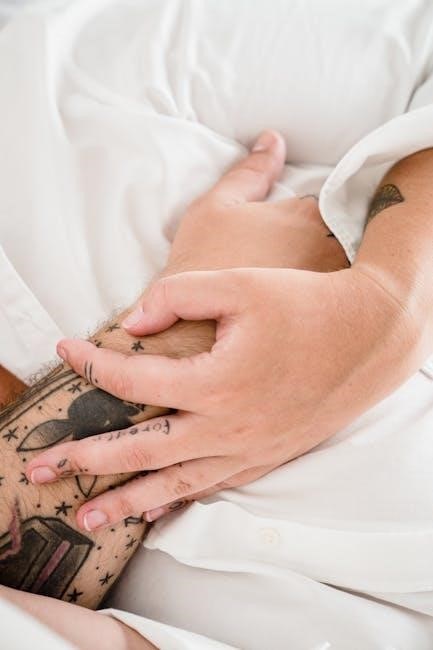Proper tattoo aftercare is essential for healing and maintaining vibrant results. Treat your tattoo as a wound to minimize infection risks and ensure optimal recovery. Follow daily maintenance routines, use recommended products, and avoid harmful activities to preserve your tattoo’s appearance. Adhering to aftercare instructions ensures proper healing and long-lasting results.

Why Proper Aftercare is Essential
Proper tattoo aftercare is crucial for promoting healing, preventing infections, and ensuring the tattoo retains its vibrancy. A new tattoo is essentially a wound, and neglecting care can lead to complications like scarring or ink fading. By following aftercare instructions, you minimize infection risks and support the skin’s natural healing process. This helps the tattoo heal evenly and maintains its aesthetic appeal. Improper care can result in prolonged healing, discomfort, or even the need for touch-ups. Prioritizing aftercare ensures your tattoo heals smoothly and looks its best for years to come. Consistency and attention to detail are key to achieving optimal results.

Understanding the Healing Process
The healing process involves stages of skin recovery, requiring cleanliness to prevent infection and promote proper tissue repair. Aftercare ensures each stage progresses smoothly for optimal results.
Initial Healing Stages
The initial healing stages of a tattoo are critical. After removing the bandage, the tattoo should be gently washed with mild antibacterial soap. Pat dry with a clean towel and apply a thin layer of recommended ointment. Keep the area clean to prevent infection. Avoid tight clothing that may irritate the tattoo. During the first few days, the tattoo may ooze ink and plasma, forming a protective scab. Avoid picking at scabs or scratching, as this can damage the design. Maintain a clean environment and avoid direct sun exposure. Proper care during this phase ensures a smooth transition into the next healing stages.

Timeline of Tattoo Healing
The healing process of a tattoo typically follows a structured timeline. In the first 24 hours, the tattoo is most vulnerable, requiring immediate care like washing and applying ointment. Within the first week, a protective scab forms, and the tattoo may ooze ink. By the second week, the scab usually peels off, revealing a lighter layer of skin. Weeks 2-3 involve gradual healing, with the tattoo starting to look more vibrant. Full healing can take up to 3-4 months, as the skin regenerates. Proper aftercare during each phase is crucial to ensure the tattoo heals evenly and retains its color. Healing times may vary depending on individual skin types and care practices.

Immediate Post-Tattoo Care
Remove the bandage within 12 hours, then gently wash the tattoo with antibacterial soap. Pat dry and apply a thin layer of recommended ointment, like Aquaphor, to promote healing.
Removing the Bandage
After getting a tattoo, the artist typically covers it with a bandage to protect it from bacteria and contaminants. It’s crucial to remove the bandage within 12 hours to prevent moisture buildup, which can lead to bacteria growth. To remove the bandage, wash your hands thoroughly with soap and water. Gently peel off the bandage, taking care not to pull too quickly, as this might irritate the sensitive skin. Once removed, inspect the tattoo for any signs of irritation or abnormal discharge. If everything looks normal, proceed to wash the tattoo as instructed.
Washing the Tattoo
Gently washing your tattoo is a critical step in the healing process. Use mild, antibacterial soap and lukewarm water to clean the area 2-3 times daily. Avoid using harsh scrubbers or exfoliating cloths, as they can damage the delicate skin. Instead, use your clean hands to gently massage the soap into the tattoo, ensuring all areas are covered. Rinse thoroughly with clean water, making sure no soap residue remains. Pat the area dry with a clean, non-abrasive towel—avoid rubbing, as this can irritate the tattoo. Keeping the tattoo clean prevents infection and promotes a smooth recovery.
Recommended Aftercare Products
Use mild, antibacterial ointments like Aquaphor or specialized tattoo aftercare creams. These products promote healing, prevent infection, and keep the tattoo moisturized. Always consult your tattoo artist for recommendations.
Top-Rated Ointments and Creams
When it comes to tattoo aftercare, choosing the right products is crucial. Aquaphor Healing Ointment is a top recommendation, known for its gentle, non-greasy texture that locks in moisture and promotes healing. Another popular option is Bacitracin, an antibacterial ointment that helps prevent infection. Tattoo-specific creams like After Inked and H2Ocean are also highly regarded for their nourishing properties. These products are designed to keep the tattoo moist, reducing the risk of scabbing and irritation. Always opt for fragrance-free and hypoallergenic options to minimize allergic reactions. Remember, a thin layer is sufficient—excess product can clog pores and hinder healing.
Natural vs. Chemical-Based Products
When choosing tattoo aftercare products, debates often arise between natural and chemical-based options. Natural products, such as coconut oil, shea butter, and herbal creams, are praised for their gentle, non-irritating properties and alignment with organic healing. They are ideal for sensitive skin and promote a chemical-free recovery process. On the other hand, chemical-based products like Aquaphor and Bacitracin are highly effective for their antibacterial properties and ability to lock in moisture. Ultimately, the choice depends on personal preference and skin type. Some tattoo artists recommend hybrid products that combine natural ingredients with essential chemicals for balanced care; Always prioritize products free from harsh additives and fragrances to avoid irritation during healing.

Daily Care Routine
Maintain your tattoo’s health by washing it 2-3 times daily with mild antibacterial soap, gently patting dry, and applying a thin layer of recommended ointment. Avoid harsh products and keep the area moisturized to prevent dryness and promote healing.
Morning and Evening Care
Start your day by gently washing your tattoo with antibacterial soap, pat it dry, and apply a thin layer of ointment. Repeat this process in the evening to maintain cleanliness and hydration. Ensure your hands are clean before touching the tattoo to prevent infection. Avoid using harsh products and opt for fragrance-free, non-comedogenic lotions. Consistency is key to promoting healing and keeping the tattoo vibrant. By following this routine, you support the skin’s natural repair process and reduce the risk of complications. Remember to air dry the tattoo after washing to prevent bacterial growth.
Moisturizing Techniques
Moisturizing is crucial for keeping your tattoo hydrated and promoting healing. Use a fragrance-free, non-comedogenic lotion or ointment, applying a thin layer 2-3 times daily. Gently massage the product into the skin with clean hands until fully absorbed. Avoid heavy or greasy products that can clog pores. Reapply after washing or if the skin feels dry. Natural products like coconut oil or shea butter can be effective, but ensure they’re free of harsh chemicals. Over-moisturizing can lead to shiny skin, so apply sparingly. Keep the tattoo hydrated consistently to prevent cracking and promote a smooth recovery. Proper moisturizing helps maintain vibrant colors and ensures the skin heals evenly.
What to Avoid During Healing
Avoid submerging your tattoo in water, using harsh chemicals, or wearing tight clothing. Refrain from scratching or picking at the tattoo and avoid excessive sun exposure.
Activities That Can Damage the Tattoo
Activities that can damage a healing tattoo include swimming in pools, lakes, or oceans, as these harbor bacteria. Avoid excessive sweating through intense workouts, as it can irritate the skin. Refrain from wearing tight clothing that may rub against the tattoo, causing friction and potential scarring. Do not submerge the tattoo in water, such as taking baths or using hot tubs, until fully healed. Avoid direct sunlight and tanning beds, as UV rays can fade ink and cause sunburn. Lastly, never pick at scabs or peel skin, as this can lead to infections or permanent damage. These activities must be avoided to ensure proper healing and a vibrant result.
Products to Avoid
During the healing process, avoid using harsh products containing alcohol, artificial fragrances, or exfoliants, as these can irritate the skin and delay healing. Never use Neosporin or other antibiotic ointments, as they may cause allergic reactions. Avoid products with harsh chemicals, such as bleach or astringents, which can damage the tattoo. Do not use fake tan or self-tanning products, as they can adhere to the tattoo and cause discoloration. Additionally, avoid products with petroleum jelly, as they can suffocate the skin and hinder healing. Instead, opt for fragrance-free, non-comedogenic, and antibacterial products specifically designed for tattoo aftercare. Always consult your tattoo artist for recommendations on safe products to use during recovery.
Common Mistakes to Avoid
Avoid over-washing, under-washing, and picking at the tattoo, as these can lead to irritation, scarring, or delayed healing. Always follow your artist’s specific advice carefully.
Over-Washing and Under-Washing
Over-washing can strip the tattoo of its natural oils, leading to dryness and potential irritation. Conversely, under-washing allows bacteria to accumulate, increasing infection risks. It’s crucial to find a balance by washing the tattoo 2-3 times daily with mild, antibacterial soap. Gently massage the area with clean hands, then rinse thoroughly with warm water. Avoid harsh scrubbing, as this can damage the delicate skin. Pat dry with a clean towel, and apply a thin layer of recommended ointment. Consistency is key to promoting healing without causing harm. Always follow your artist’s guidance for optimal results.
Scratching and Picking at the Tattoo
Scratching or picking at your tattoo can lead to serious damage, such as removing ink, causing scarring, or delaying healing. During the healing process, the tattoo may itch or form a crust, but it’s crucial to resist the urge to scratch or pick. Instead, gently pat the area with a clean hand or apply a thin layer of recommended ointment to soothe irritation. Picking can introduce bacteria, increasing the risk of infection. Allow the tattoo to heal naturally, and avoid touching it unnecessarily. Keeping the area clean and moisturized will help reduce itching and prevent complications. Always prioritize patience to ensure your tattoo heals properly and retains its quality.

Signs of Infection and Complications
Watch for redness, swelling, pain, or pus, which may indicate infection. If symptoms persist beyond a few days, consult a professional promptly to address complications.
Recognizing Infection Symptoms
Identifying infection early is crucial. Look for signs such as increased redness, swelling, or tenderness around the tattoo. Pus or discharge, especially with a foul odor, is a clear indicator. Unusual warmth or a rash may also signal infection. Additionally, systemic symptoms like fever or chills can occur if the infection spreads. If you experience any of these, seek professional medical advice immediately to prevent complications and ensure proper treatment. Monitoring your tattoo daily during the healing process helps catch potential issues before they escalate, ensuring a safe and effective recovery.

When to Seek Professional Help
Seek professional help if you notice persistent redness, swelling, or pain beyond the initial healing phase. Signs like pus, discharge, or a foul odor indicate potential infection. Fever, chills, or spreading redness around the tattoo are severe symptoms requiring immediate medical attention. If your tattoo isn’t healing as expected or you develop unusual scabbing, consult your artist or a healthcare professional. Ignoring these signs can lead to serious complications. Timely intervention ensures proper treatment and prevents long-term damage to your tattoo and skin. Always prioritize your health by seeking expert advice when unsure about your tattoo’s healing progress.

Long-Term Tattoo Maintenance
Protect your tattoo from sun exposure to prevent fading. Moisturize regularly to keep the ink vibrant. Avoid harsh products that may damage the tattoo over time.
Keep Your Tattoo Vibrant
To maintain your tattoo’s vibrancy, apply sunscreen with high SPF when exposed to sunlight, as UV rays can cause ink to fade. Regularly moisturize using gentle, non-abrasive products to keep the skin hydrated and the ink intact. Avoid excessive exfoliation or harsh chemicals, as these can dull the colors. Touch-ups may be necessary over time to restore brightness. Consult your artist for recommendations tailored to your tattoo’s needs. Proper care ensures your artwork remains vivid and striking for years to come.
Protecting Your Tattoo from the Sun
Protecting your tattoo from the sun is crucial to prevent fading and ink degradation. Use a broad-spectrum sunscreen with at least SPF 30 whenever your tattoo is exposed. Reapply every two hours or immediately after swimming or sweating. Avoid direct sun exposure during peak hours (10 AM–4 PM). Cover your tattoo with clothing or seek shade when possible. UV rays can cause ink to fade and skin to blister, leading to irreversible damage. Regular sun protection helps maintain the tattoo’s vibrancy and prevents long-term discoloration. Be consistent with sun care to ensure your tattoo remains intact and striking for years.

Consistent aftercare ensures vibrant, long-lasting results. Follow your artist’s advice, keep the tattoo clean, and avoid harmful products. Patience and dedication will preserve your tattoo’s beauty for years.
Proper tattoo aftercare involves gentle cleaning with antibacterial soap, pat drying, and applying thin layers of recommended ointments. Avoid submerging the tattoo in water, sunlight exposure, and harsh products. Refrain from picking scabs or scratching, as this can damage the design. Follow your artist’s specific instructions, as healing processes vary. Maintain a consistent routine to promote healing and preserve vibrancy. By adhering to these practices, you ensure a smooth recovery and a tattoo that remains vibrant for years to come.
Final Thoughts on Tattoo Aftercare
Taking care of your new tattoo is a commitment that ensures its longevity and beauty. By following proper aftercare practices, you protect your investment and maintain healthy skin. Remember, every tattoo heals differently, so adapt your routine as needed. Consistency is key to preventing complications and achieving desired results. Always prioritize hygiene, avoid harmful products, and seek professional advice if concerns arise. With patience and dedication, your tattoo will heal beautifully, becoming a lasting piece of art you can cherish for years to come.